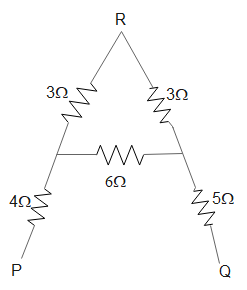
The effective resistance between P and Q for the following network is:

A) $\dfrac{1}{{12}} \Omega$
B) $21\Omega $
C) $12\Omega $
D) $\dfrac{1}{{21}}\Omega $
Answer
219k+ views
Hint: In the given circuit we can see that many resistances are connected. In circuits resistances can be connected in series and parallel combinations. The net resistance between points P and Q can be found by solving these combinations. So we are going to use the following formulae of series and parallel combinations of resistances.
Series combination:
\[R = {R_1} + {R_2}\]
Parallel combination:
$\dfrac{1}{R} = \dfrac{1}{{{R_1}}} + \dfrac{1}{{{R_2}}}$
Complete step by step solution:
Let $4\Omega $resistance is ${R_1}$, $3\Omega $ resistance is ${R_2}$, other $3\Omega $ resistance is ${R_3}$, $5\Omega$ resistance is ${R_4}$ and $6\Omega$ resistance is ${R_5}$.
Between points A and B resistances \[{R_2}\] and \[{R_3}\] are in series.
Let their resultant is \[{R'}\].
So \[{R'} = {R_2} + {R_3}\]
Putting the values of \[{R_2}{\text{ and }}{R_3}\]
\[\Rightarrow {R'} = 3 + 3\]
\[\Rightarrow {R'} = 6{\text{ }}\Omega \]
\[\Rightarrow {R'}\] and \[{R_5}\] are in parallel. Let their resultant is \[{R^{''}}\].
$\Rightarrow \dfrac{1}{{{R^{''}}}} = \dfrac{1}{{{R'}}} + \dfrac{1}{{{R_5}}}$
Putting the values of \[{R'}\] and \[{R_5}\]
$\Rightarrow \dfrac{1}{{{R^{''}}}} = \dfrac{1}{6} + \dfrac{1}{6}$
$\Rightarrow \dfrac{1}{{{R^{''}}}} = \dfrac{2}{6}$
$\Rightarrow \dfrac{1}{{{R^{''}}}} = \dfrac{1}{3}$
$\Rightarrow {R^{''}} = 3{\text{ }}\Omega $
Now,\[{R^{''}}\], \[{R_1}\]and \[{R_4}\]are in series. Let their resultant is R.
So, \[R = {R^{''}} + {R_1} + {R_4}\]
Putting the values of \[{R^{''}},{R_1}{\text{ and }}{R_4}\]
$\Rightarrow R = 4 + 3 + 5$
$\Rightarrow R = 12\Omega $
The resultant resistance between points P and Q is $R = 12 \Omega $.
Note: In the questions where circuits are presented we have to be careful while finding the series and parallel combinations of resistances. The circuit given in the question has resistances only so it is sort of basic and easy. But circuits can be very complicated when capacitors and inductors are also involved in the circuit. In such conditions we have to find the total resistance considering the impedance created by the capacitors and inductors also. The impedance in case of capacitor is given by following formula,
${X_c} = \dfrac{1}{{\omega C}}$
Where, $\omega $ is the angular frequency ${s^{ - 1}}$ and
C is the capacitance in coulomb
The impedance in case of inductor is given by following formula,
${X_c} = \omega L$
Where, $\omega $ is the angular frequency ${s^{ - 1}}$ and
L is the inductance in Henry
So circuits consisting of capacitors, inductors we will use above formulae to find net impedance.
Series combination:
\[R = {R_1} + {R_2}\]
Parallel combination:
$\dfrac{1}{R} = \dfrac{1}{{{R_1}}} + \dfrac{1}{{{R_2}}}$
Complete step by step solution:
Let $4\Omega $resistance is ${R_1}$, $3\Omega $ resistance is ${R_2}$, other $3\Omega $ resistance is ${R_3}$, $5\Omega$ resistance is ${R_4}$ and $6\Omega$ resistance is ${R_5}$.
Between points A and B resistances \[{R_2}\] and \[{R_3}\] are in series.
Let their resultant is \[{R'}\].
So \[{R'} = {R_2} + {R_3}\]
Putting the values of \[{R_2}{\text{ and }}{R_3}\]
\[\Rightarrow {R'} = 3 + 3\]
\[\Rightarrow {R'} = 6{\text{ }}\Omega \]
\[\Rightarrow {R'}\] and \[{R_5}\] are in parallel. Let their resultant is \[{R^{''}}\].
$\Rightarrow \dfrac{1}{{{R^{''}}}} = \dfrac{1}{{{R'}}} + \dfrac{1}{{{R_5}}}$
Putting the values of \[{R'}\] and \[{R_5}\]
$\Rightarrow \dfrac{1}{{{R^{''}}}} = \dfrac{1}{6} + \dfrac{1}{6}$
$\Rightarrow \dfrac{1}{{{R^{''}}}} = \dfrac{2}{6}$
$\Rightarrow \dfrac{1}{{{R^{''}}}} = \dfrac{1}{3}$
$\Rightarrow {R^{''}} = 3{\text{ }}\Omega $
Now,\[{R^{''}}\], \[{R_1}\]and \[{R_4}\]are in series. Let their resultant is R.
So, \[R = {R^{''}} + {R_1} + {R_4}\]
Putting the values of \[{R^{''}},{R_1}{\text{ and }}{R_4}\]
$\Rightarrow R = 4 + 3 + 5$
$\Rightarrow R = 12\Omega $
The resultant resistance between points P and Q is $R = 12 \Omega $.
Note: In the questions where circuits are presented we have to be careful while finding the series and parallel combinations of resistances. The circuit given in the question has resistances only so it is sort of basic and easy. But circuits can be very complicated when capacitors and inductors are also involved in the circuit. In such conditions we have to find the total resistance considering the impedance created by the capacitors and inductors also. The impedance in case of capacitor is given by following formula,
${X_c} = \dfrac{1}{{\omega C}}$
Where, $\omega $ is the angular frequency ${s^{ - 1}}$ and
C is the capacitance in coulomb
The impedance in case of inductor is given by following formula,
${X_c} = \omega L$
Where, $\omega $ is the angular frequency ${s^{ - 1}}$ and
L is the inductance in Henry
So circuits consisting of capacitors, inductors we will use above formulae to find net impedance.
Recently Updated Pages
Two discs which are rotating about their respective class 11 physics JEE_Main

A ladder rests against a frictionless vertical wall class 11 physics JEE_Main

Two simple pendulums of lengths 1 m and 16 m respectively class 11 physics JEE_Main

The slopes of isothermal and adiabatic curves are related class 11 physics JEE_Main

A trolly falling freely on an inclined plane as shown class 11 physics JEE_Main

The masses M1 and M2M2 M1 are released from rest Using class 11 physics JEE_Main

Trending doubts
JEE Main 2026: Application Form Open, Exam Dates, Syllabus, Eligibility & Question Papers

Understanding Uniform Acceleration in Physics

Derivation of Equation of Trajectory Explained for Students

Hybridisation in Chemistry – Concept, Types & Applications

Understanding the Angle of Deviation in a Prism

Understanding Collisions: Types and Examples for Students

Other Pages
JEE Advanced Marks vs Ranks 2025: Understanding Category-wise Qualifying Marks and Previous Year Cut-offs

Units And Measurements Class 11 Physics Chapter 1 CBSE Notes - 2025-26

NCERT Solutions For Class 11 Physics Chapter 8 Mechanical Properties Of Solids

Motion in a Straight Line Class 11 Physics Chapter 2 CBSE Notes - 2025-26

NCERT Solutions for Class 11 Physics Chapter 7 Gravitation 2025-26

Understanding Atomic Structure for Beginners




